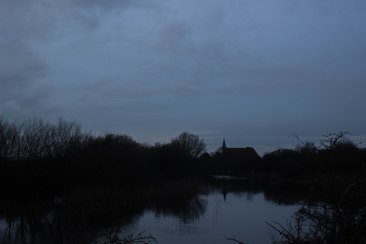Well, the time has come. I’m afraid we’re going to have to have a difficult conversation. Oh, I hoped I’d never have to have this talk with you, but I can no longer deny what’s staring us in the face. It’s time to take the bull by the horns and deal with it straight on.
I’m going to have to talk to you about Kent.
Much though we’d like to ignore the Evil County and pretend it just doesn’t exist, there are times when its presence simply has to be acknowledged and in the area around Rye, there’s nothing for it but to accept that it is there and that there is simply nothing to be done about it. One curious thing about it is that parts of it are even acceptable to upright, proper folk, and those are the parts that were, essentially, made by Sussex.
The River Rother rises near Rotherfield in the High Weald and flows east. At one time it flowed into a large estuary, which also received the waters of several other High Wealden rivers, like the Brede and the Tillingham. At this time the great shingle headland of Dungeness didn’t exist and the whole coastline was quite different to how it is today. Something about the shape of the seabed, however, made a long shingle spit begin to form, starting with a small island out to sea, not far from where Old Romney is today. Eventually the spit joined the island to the shore, creating a lagoon behind it that the rivers continued to empty into. Some people also built a town on the spit and called it Winchelsea. That later turned out to have been a bad idea.
Over time the rivers filled the lagoon with their waters and also their silt. After a while the water became too much and it punched its way through the shingle bank and found its way to the sea once again. As the waters drained out, the silt left behind became salt marshes that, over hundreds of years, were gradually drained and converted to farmland in a process called Inning. Thus, Romney and Walland Marshes and the Rother Levels were created from the mud of the Sussex High Weald and the coastline around Rye Bay was changed forever. So if you’ve ever wondered why Romney Marsh feels less sinister than the rest of Kent, here’s your answer. It is made from the soils and rocks of the Good County to its west.
Eventually the shingle spit was washed away and resurfaced as Dungeness; the old town of Winchelsea departing with it. Edward I founded the present town on its hill nearby. The rivers were forced into new shapes, all of them joining the Rother near Rye and flowing to the sea at Rye Harbour. For a time, before all of the spit had been destroyed, the lagoon survived and was deep enough to shelter several ships in an area behind the old town of Winchelsea known as “La Chambre”, or “The Camber”. Camber Sands and its adjoining town keep this name to this day.
I seem to have gone on rather a bit. Sorry about that. The main point of all this waffle is that there is now a rather beautiful, bleak nature reserve, absolutely teeming with bird life, on the shingle at Rye Harbour and the other day I went for a stroll around it in the wonderfully atmospheric early spring mists and here are some photographs to prove it. I hope you enjoy them.




















